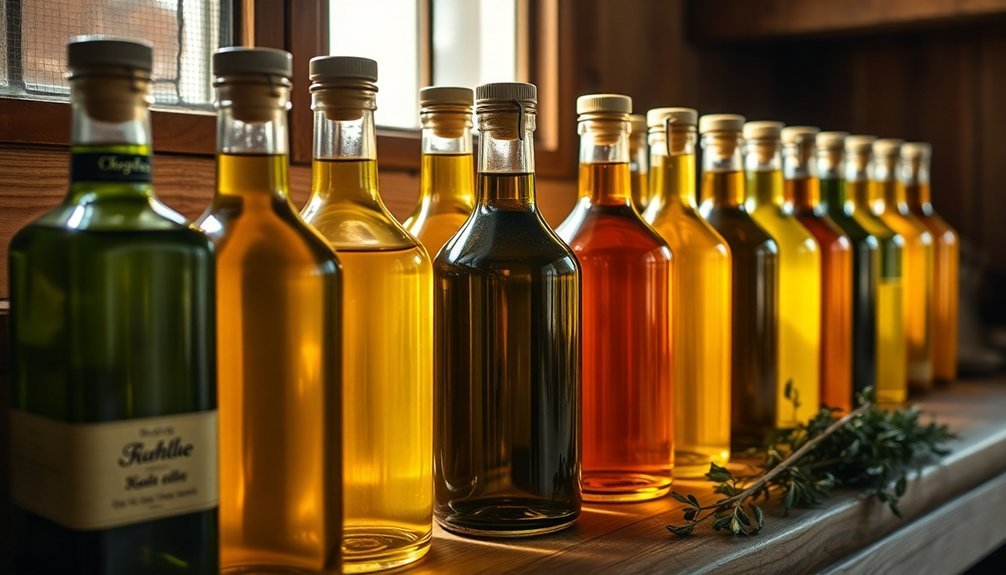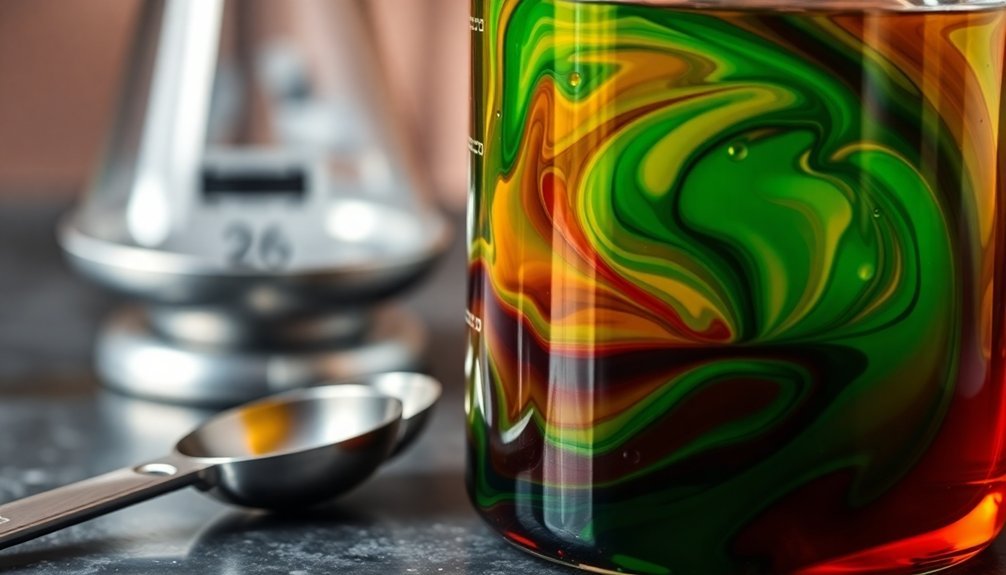Your oil mixtures can fail due to overlooked compatibility issues, incorrect blending ratios, and poor storage practices. You'll see problems when you don't balance top, middle, and base notes properly or maintain ideal temperatures during mixing. Contamination and oxidation will ruin your blends if you're not using proper containers and following dilution guidelines. Watch out for photosensitive combinations and improper ratios. Master these fundamentals to reveal the secrets of successful oil blending.
Understanding Essential Oil Compatibility and Reactions

While essential oils offer numerous therapeutic benefits, certain combinations can pose significant risks to your health and well-being. You'll need to be especially cautious with common pairings like mint and eucalyptus, which can trigger respiratory issues and skin irritation.
Similarly, mixing citrus oils with cinnamon can lead to severe membrane irritation due to their chemical compounds interacting. Using these oils together can cause severe skin damage and heightened sensitivity.
Don't underestimate the importance of proper dilution and quality control. You should always use pure, authentic oils and maintain dilutions between 1-5%.
If you're applying oils to your skin, remember that damaged or inflamed areas are more susceptible to reactions. Before trying any new blend, perform a patch test and check for potential incompatibilities.
Pay special attention to photosensitive combinations like bergamot and lemon, which can cause severe sunburns.
Top Notes, Middle Notes, and Base Notes Balance
Beyond understanding oil compatibility, mastering the art of blending requires knowledge of fragrance layers. Your blend's success depends on balancing top, middle, and base notes, which work together like a symphony. Top notes create the first impression but evaporate quickly, while middle notes form the heart of your blend and last several hours. Base notes anchor the fragrance and provide lasting power. Personal preference ultimately determines if your blend works harmoniously.
For successful blending, remember these key principles:
- Start with a 30/50/20 ratio (top/middle/base) and adjust based on your desired outcome
- Choose complementary oils within the same fragrance family
- Test your blend on fragrance strips before finalizing
When you're mixing, begin with middle notes as your foundation, then add top notes for immediate impact and base notes to lock in the scent. This approach guarantees a well-rounded, professional-quality blend that evolves beautifully over time.
Proper Storage Techniques for Long-Lasting Blends

Proper storage techniques greatly impact the longevity and quality of your oil blends. You'll need to store your mixtures in a cool, dry place between 32-77°F, away from direct sunlight and extreme temperature variations.
Keep your blends in clean, sealable containers that are clearly labeled to prevent cross-contamination. Always check that safety data sheets are readily available near storage areas for quick reference during handling.
For drum storage, position them on their sides with bungs horizontal to maintain proper sealing. If you're using metal drums, place them on wooden shims to prevent ground contact and corrosion.
Don't forget to rotate them annually. When storing grease-based blends, keep containers upright to prevent separation.
Implement a FIFO system and mark opening dates on containers. You'll want to use products within a year and maintain separate pumps and tools for different mixtures to guarantee blend integrity.
Temperature Control During Blending Process
Maintaining precise temperature control during oil blending is essential for product quality and stability.
You'll want to keep temperatures between 55-65°C to guarantee proper component fluidity and prevent deterioration of your oils and additives.
Your blending success depends on proper temperature management to avoid these common issues:
- Air bubbles disrupting the precise metering of components
- Oxidation and thermal breakdown of essential additives
- Inconsistent mixing leading to poor product quality
Modern blending facilities use automated control systems and insulated vessels clad with GI sheets to maintain ideal temperatures.
If you're running a blending operation, invest in quality heating and cooling systems, including thermic fluid heaters and drum heating ovens.
Measuring and Ratio Fundamentals

With temperature control in place, accurate measurement becomes your next key focus for oil blending success.
You'll need to master both water displacement for solid oils and specialized measuring tools for liquid mixtures. When measuring solid oils, use cool water to prevent melting, and double your water measurement before adding the oil.
For precise gas-oil ratios, you'll find the Ratio Rite cup invaluable. It's specifically designed with clear markings for multiple units and accommodates ratios from 16:1 to 70:1.
Always check your engine manual for the correct ratio, and don't forget to match the right measuring cup to your ingredient type – dry cups for solids and liquid cups for fluids.
Common Contamination Sources to Avoid
You'll find that industrial debris often enters oil systems through damaged seals, worn gaskets, and improperly sealed fill ports during maintenance procedures.
When it comes to moisture control, you need to focus on using desiccant breathers, maintaining proper storage temperatures, and keeping containers sealed to prevent water ingress.
Your best defense against these common contaminants includes regular inspection of sealing points and implementing proper handling protocols that minimize exposure to environmental elements.
Industrial Debris Entry Points
Understanding where contaminants enter industrial oil systems is essential for preventing equipment damage and extending lubricant life. Your equipment faces constant exposure to debris through multiple entry points during daily operations, making it vital to identify and monitor these vulnerable areas.
Common industrial debris entry points include:
- Worn seals and gaskets that allow dust, dirt, and moisture to seep into machinery
- Open hatches and fill ports during maintenance procedures or oil changes
- Damaged breather caps and vents that fail to filter incoming air
You'll find that manufacturing processes create additional risks through airborne particles from concrete dust, metal shavings, and coal fines.
Water contamination often occurs through faulty cooling systems or steam exposure, while improper storage and handling practices can introduce contaminants before the oil even reaches your equipment.
Moisture Control Best Practices
Having identified the entry points for debris in your industrial systems, protecting your oil from moisture contamination requires specific preventive measures.
You'll need to focus on three critical areas: environmental exposure, oil properties, and water management.
Start by installing desiccant breathers and maintaining proper seals to prevent environmental moisture infiltration.
When handling hygroscopic oils like POE, PAG, or PVE, you'll need extra caution as they readily absorb moisture from the air.
Don't use oils from opened or compromised containers, as they're likely already contaminated.
Watch for signs of emulsified water, which appears as cloudiness in your lubricant.
You can minimize this risk by implementing good warehousing practices, conducting regular monitoring, and using appropriate filtration systems to manage existing contamination levels.
Quality Assessment of Base Oils

To guarantee ideal base oil quality, you'll need to understand both traditional refining methods and modern hydrocracking processes that affect viscosity and purity.
You can quickly assess oxidation resistance by examining the base oil's acid number, which shouldn't exceed 0.05 mg KOH/g according to standard specifications.
Testing oxidation stability will give you vital insights into the oil's long-term performance, as oxidation rates double with every 10°C temperature increase.
Base Oil Refinement Methods
When producing high-quality base oils, manufacturers rely on three primary refinement methods: acid/clay refining, solvent refining, and catalytic hydrogenation.
While acid/clay refining was once popular, it's now largely outdated due to environmental concerns and its production of harmful acid sludge.
Today's manufacturers prefer these more effective methods:
- Solvent refining, which uses furfural to extract aromatics and unwanted components, creating clean raffinates
- Catalytic hydrogenation, converting over 90% of aromatics to hydrocarbons at temperatures of 150-420°C
- De-waxing and hydrofinishing processes that enhance oil stability and low-temperature performance
You'll find that catalytic hydrogenation, introduced in the 1980s, offers the highest purity but may require additional seal swell agents due to its low aromatic content.
Each method must meet strict quality standards, including water content below 100 ppm and specific flash point requirements.
Oxidation Resistance Indicators
Base oil quality extends beyond refinement methods to include oxidation resistance – a key indicator of oil longevity and performance.
You'll find several essential indicators that reveal your oil's oxidation stability, with Oxidation Induction Time (OIT) being a primary measure through HP-DSC testing.
When evaluating your oil's oxidation resistance, you'll need to monitor key factors like base number (BN), acid formation, and viscosity changes.
Your oil's sulphur content plays an important role, though there's a threshold where additional sulphur won't improve stability.
Temperature control is critical – every 10°C increase doubles oxidation rates.
You can enhance protection by incorporating both primary antioxidants (like BHT) and secondary antioxidants (such as Dithiocarbamate), which work together to greatly extend your oil's service life.
Oxidation Prevention Strategies
Since oxidation poses a notable threat to oil quality, implementing effective prevention strategies is essential for maintaining stability and extending shelf life.
You'll want to focus on controlling temperature, as every 10°C increase doubles the oxidation rate. Keep your oils in the coolest possible environment during processing, shipping, and storage.
Protect your oil mixtures from oxidation by using these critical methods:
- Store oils in dark-colored containers to block harmful UV rays
- Use nitrogen gas to create an inert barrier above the oil
- Maintain antioxidant levels with vitamin E and natural compounds
Don't forget to minimize headspace in containers and keep moisture levels below 0.2%.
Dilution Rate Mastery

You'll need to master proper dilution rates to create safe and effective oil blends for various applications.
Understanding the right ratios, from 1% for sensitive skin to higher concentrations for acute conditions, helps you avoid common mixing errors that could lead to skin irritation.
Using precise measurements and following established dilution guidelines guarantees your oil mixtures deliver ideal results while maintaining safety standards.
Optimizing Mixing Ratios
When mixing fuel for two-stroke engines, understanding the correct oil-to-gas ratio is essential for ideal performance and engine longevity. Most engines require specific ratios like 50:1, 40:1, or 20:1, depending on your machine's design and usage.
You'll need to match the ratio to your engine's demands – higher-stress applications need more oil.
- Picture yourself carefully measuring fresh oil and gas with graduated tools
- Imagine vigorously shaking the sealed container until the mixture's completely blended
- Visualize pouring the perfect mixture into your engine's clean fuel tank
Don't forget that proper jetting, high-quality oils, and clean fuel storage all play vital roles in optimizing your mix.
For best results, always check your owner's manual and use fresh, high-quality ingredients to protect your engine's performance and lifespan.
Preventing Dilution Errors
Proper dilution rate management stands as a critical defense against engine oil contamination and degradation. You'll protect your engine by understanding and controlling factors that contribute to oil dilution.
To prevent dilution errors, you need to adopt a multi-faceted approach. Start by choosing high-quality oils with robust HTHS viscosity ratings and strong additive packages.
You'll want to monitor your driving patterns, ensuring your engine reaches proper operating temperatures to burn off excess fuel and moisture. Don't skip regular oil analysis – it's your early warning system for dilution issues.
Make sure you're using premium fuels with lower bio-element content, and maintain strict oil change intervals, especially if you make frequent short trips.
Shelf Life Extension Methods
The longevity of oil mixtures hinges on protecting them from their primary enemies: oxygen, light, heat, and moisture. You'll maximize shelf life by implementing strategic storage methods and selecting the right packaging materials.
Store your mixtures in dark glass bottles or UV-resistant containers, and keep them in a cool, dark environment. For commercial applications, consider nitrogen-flushed containers to displace harmful oxygen.
You can also incorporate natural antioxidants like vitamin E or rosemary extract to combat oxidation.
- Picture your oils stored in amber glass bottles, safely tucked away in a temperature-controlled cabinet
- Imagine tamper-proof seals gleaming under warehouse lights, protecting precious contents
- Envision smaller portion containers, reducing exposure each time you access the mixture
Frequently Asked Questions
How Do Electromagnetic Fields From Equipment Affect Oil Mixture Stability?
Electromagnetic fields from your equipment can disrupt your oil mixture's stability by breaking up complex structural units, affecting emulsifier performance, and altering molecular interactions. This changes viscosity and pour point characteristics.
Can Ultrasonic Cleaning Devices Impact the Molecular Structure of Blended Oils?
Yes, when you use ultrasonic cleaners, they'll break down your blended oils' molecular structure through cavitation. This can destroy polymer additives, alter viscosity, and change pour points in your oil mixtures.
Do Rare Earth Elements in Machinery Components Accelerate Oil Degradation?
No, you don't need to worry about rare earth elements in your machinery causing oil degradation. They're primarily used in catalysts and converters, and there's no evidence they directly affect oil breakdown or deterioration.
How Does Atmospheric Pressure Variation Influence Oil Mixture Performance?
When atmospheric pressure drops, you'll notice your oil mixture runs richer due to less oxygen availability. You'll need to adjust your fuel-oil ratios and jetting to maintain ideal performance in changing pressure conditions.
Can Radiofrequency Emissions From Nearby Electronics Affect Oil Chemical Properties?
You don't need to worry about radiofrequency emissions affecting your oil's chemical properties. They're non-ionizing and lack enough energy to break chemical bonds or alter molecular structures in your oil mixtures.
In Summary
You'll find success in your essential oil blends by focusing on proper ratios, storage, and temperature control. When you're mindful of note balancing and oil compatibility, your mixtures will maintain their therapeutic properties longer. Don't forget to use quality base oils and implement oxidation prevention strategies. Master these fundamentals, and you'll create stable, effective blends that last for months.





Leave a Reply